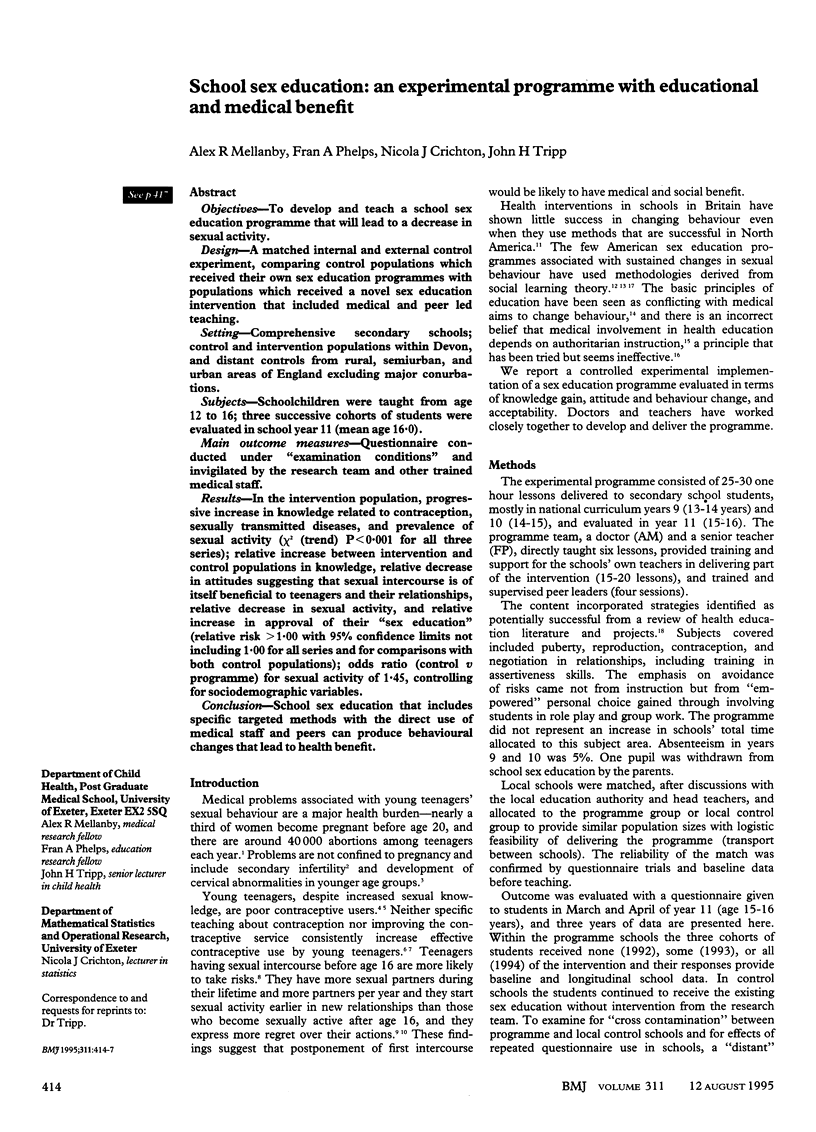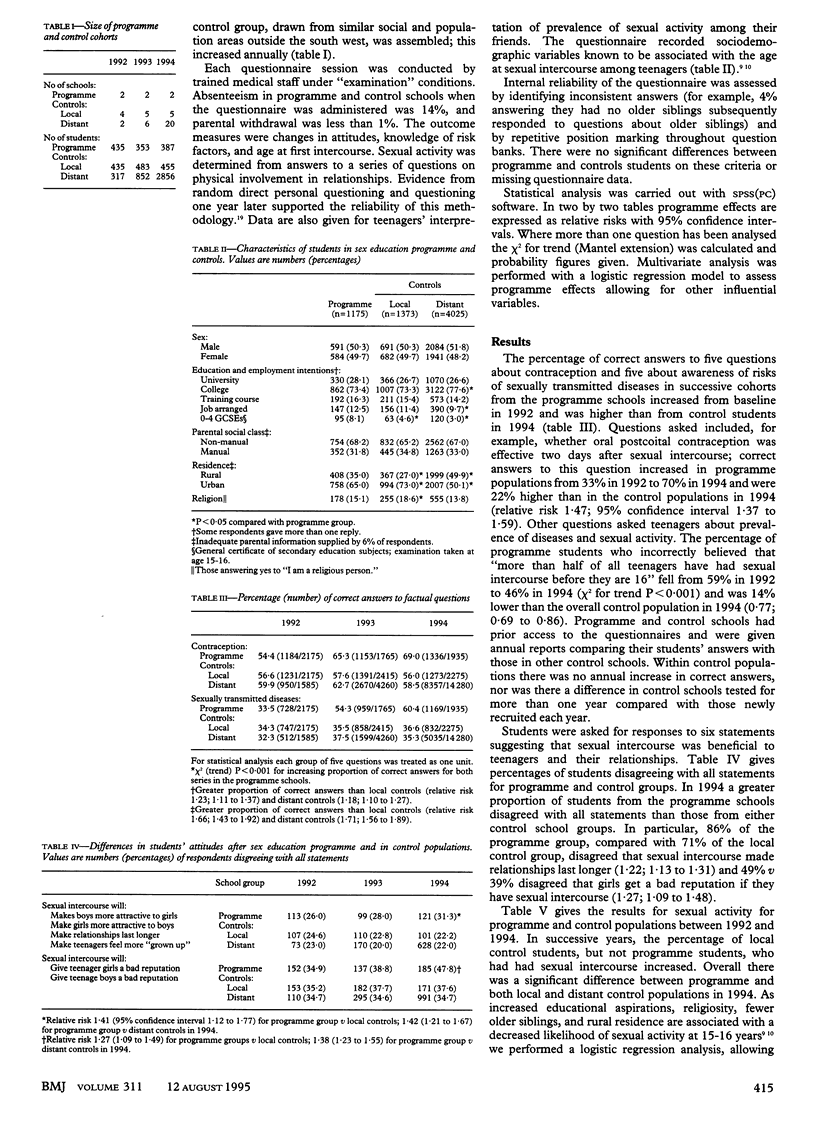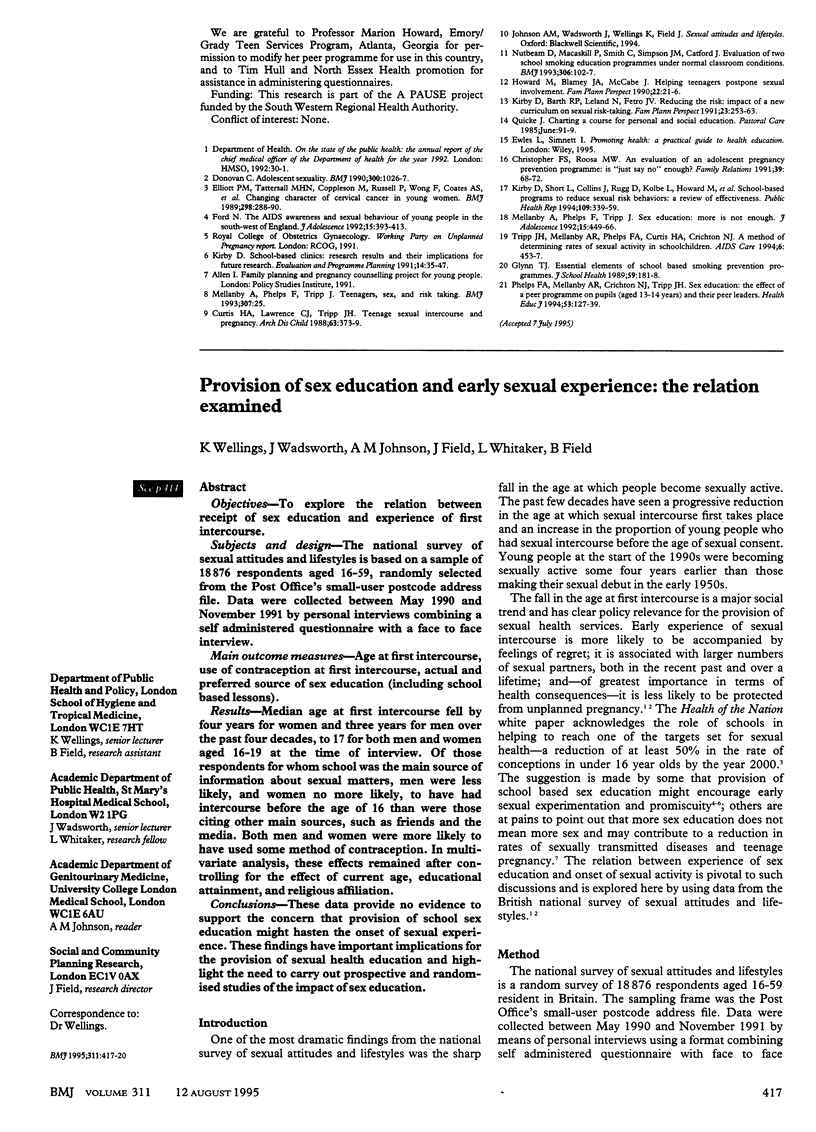Abstract
OBJECTIVES--To develop and teach a school sex education programme that will lead to a decrease in sexual activity. DESIGN--A matched internal and external control experiment, comparing control populations which received their own sex education programmes with populations which received a novel sex education intervention that included medical and peer led teaching. SETTING--Comprehensive secondary schools; control and intervention populations within Devon, and distant controls from rural, semiurban, and urban areas of England excluding major conurbations. SUBJECTS--Schoolchildren were taught from age 12 to 16; three successive cohorts of students were evaluated in school year 11 (mean age 16.0). MAIN OUTCOME MEASURES--Questionnaire conducted under "examination conditions" and invigilated by the research team and other trained medical staff. RESULTS--In the intervention population, progressive increase in knowledge related to contraception, sexually transmitted diseases, and prevalence of sexual activity (chi 2 (trend) P < 0.001 for all three series); relative increase between intervention and control populations in knowledge, relative decrease in attitudes suggesting that sexual intercourse is of itself beneficial to teenagers and their relationships, relative decrease in sexual activity, and relative increase in approval of their "sex education" (relative risk > 1.00 with 95% confidence limits not including 1.00 for all series and for comparisons with both control populations); odds ratio (control v programme) for sexual activity of 1.45, controlling for sociodemographic variables. CONCLUSION--School sex education that includes specific targeted methods with the direct use of medical staff and peers can produce behavioural changes that lead to health benefit.
Full text
PDF



Selected References
These references are in PubMed. This may not be the complete list of references from this article.
- Curtis H. A., Lawrence C. J., Tripp J. H. Teenage sexual intercourse and pregnancy. Arch Dis Child. 1988 Apr;63(4):373–379. doi: 10.1136/adc.63.4.373. [DOI] [PMC free article] [PubMed] [Google Scholar]
- Donovan C. Adolescent sexuality. BMJ. 1990 Apr 21;300(6731):1026–1027. doi: 10.1136/bmj.300.6731.1026. [DOI] [PMC free article] [PubMed] [Google Scholar]
- Elliott P. M., Tattersall M. H., Coppleson M., Russell P., Wong F., Coates A. S., Solomon H. J., Bannatyne P. M., Atkinson K. H., Murray J. C. Changing character of cervical cancer in young women. BMJ. 1989 Feb 4;298(6669):288–290. doi: 10.1136/bmj.298.6669.288. [DOI] [PMC free article] [PubMed] [Google Scholar]
- Ford N. The AIDS awareness and sexual behaviour of young people in the South-west of England. J Adolesc. 1992 Dec;15(4):393–413. doi: 10.1016/0140-1971(92)90071-c. [DOI] [PubMed] [Google Scholar]
- Glynn T. J. Essential elements of school-based smoking prevention programs. J Sch Health. 1989 May;59(5):181–188. doi: 10.1111/j.1746-1561.1989.tb04698.x. [DOI] [PubMed] [Google Scholar]
- Howard M., McCabe J. B. Helping teenagers postpone sexual involvement. Fam Plann Perspect. 1990 Jan-Feb;22(1):21–26. [PubMed] [Google Scholar]
- Kirby D., Barth R. P., Leland N., Fetro J. V. Reducing the risk: impact of a new curriculum on sexual risk-taking. Fam Plann Perspect. 1991 Nov-Dec;23(6):253–263. [PubMed] [Google Scholar]
- Kirby D., Short L., Collins J., Rugg D., Kolbe L., Howard M., Miller B., Sonenstein F., Zabin L. S. School-based programs to reduce sexual risk behaviors: a review of effectiveness. Public Health Rep. 1994 May-Jun;109(3):339–360. [PMC free article] [PubMed] [Google Scholar]
- Mellanby A., Phelps F., Tripp J. H. Teenagers, sex, and risk taking. BMJ. 1993 Jul 3;307(6895):25–25. doi: 10.1136/bmj.307.6895.25. [DOI] [PMC free article] [PubMed] [Google Scholar]
- Mellanby A., Phelps F., Tripp J. Sex education: more is not enough. J Adolesc. 1992 Dec;15(4):449–466. doi: 10.1016/0140-1971(92)90074-f. [DOI] [PubMed] [Google Scholar]
- Nutbeam D., Macaskill P., Smith C., Simpson J. M., Catford J. Evaluation of two school smoking education programmes under normal classroom conditions. BMJ. 1993 Jan 9;306(6870):102–107. doi: 10.1136/bmj.306.6870.102. [DOI] [PMC free article] [PubMed] [Google Scholar]
- Tripp J. H., Mellanby A. R., Phelps F. A., Curtis H. A., Crichton N. J. A method for determining rates of sexual activity in schoolchildren. AIDS Care. 1994;6(4):453–457. doi: 10.1080/09540129408258660. [DOI] [PubMed] [Google Scholar]


